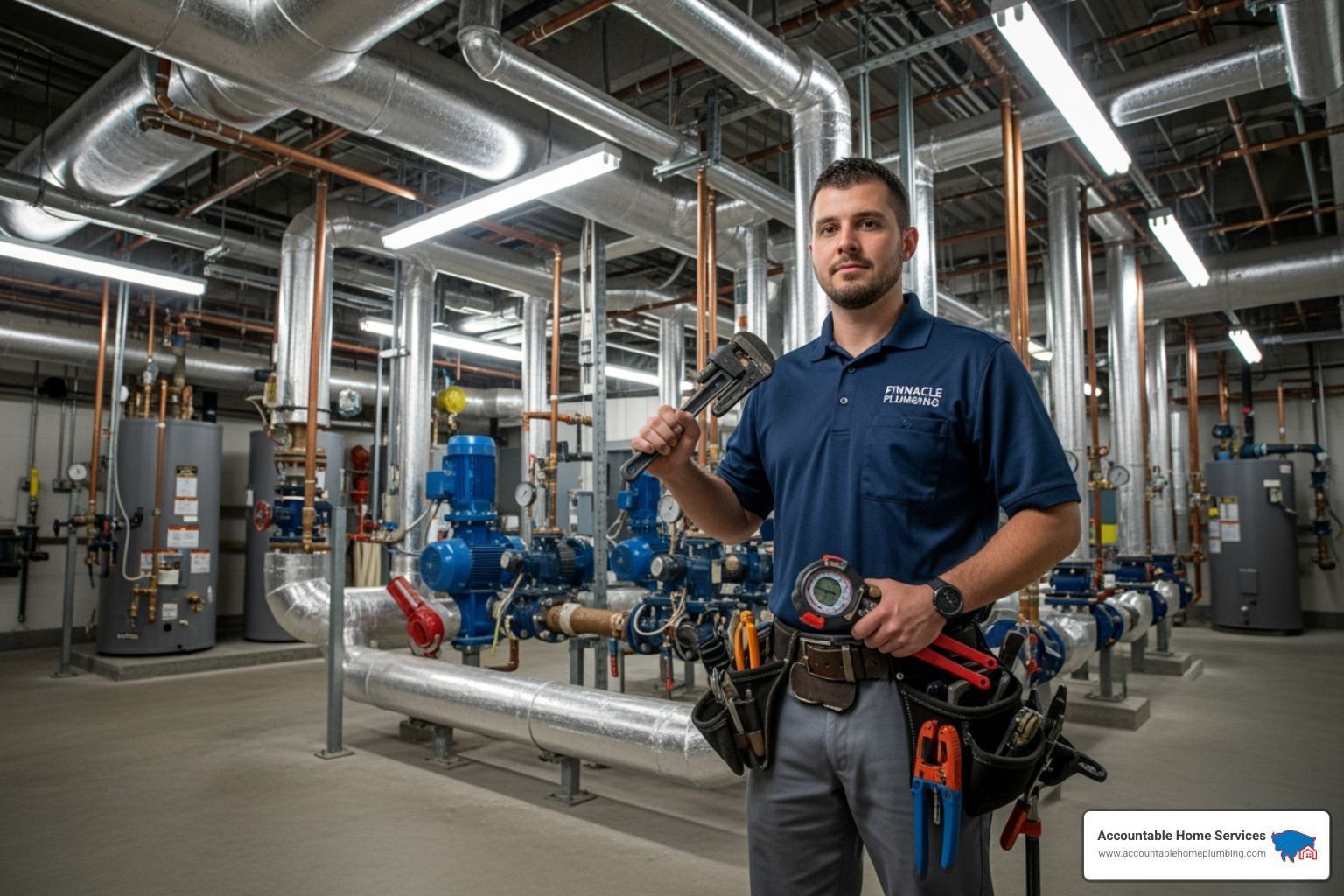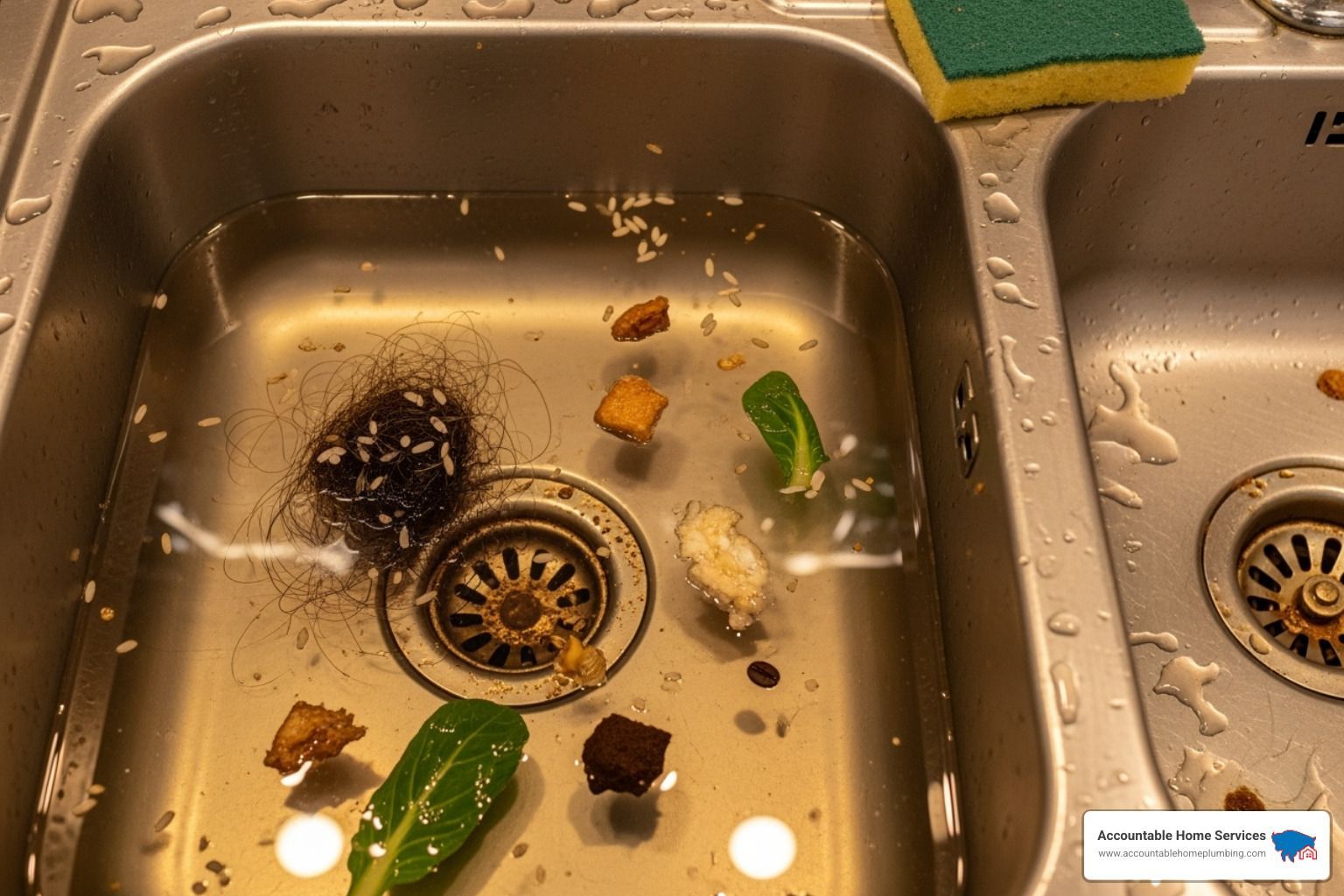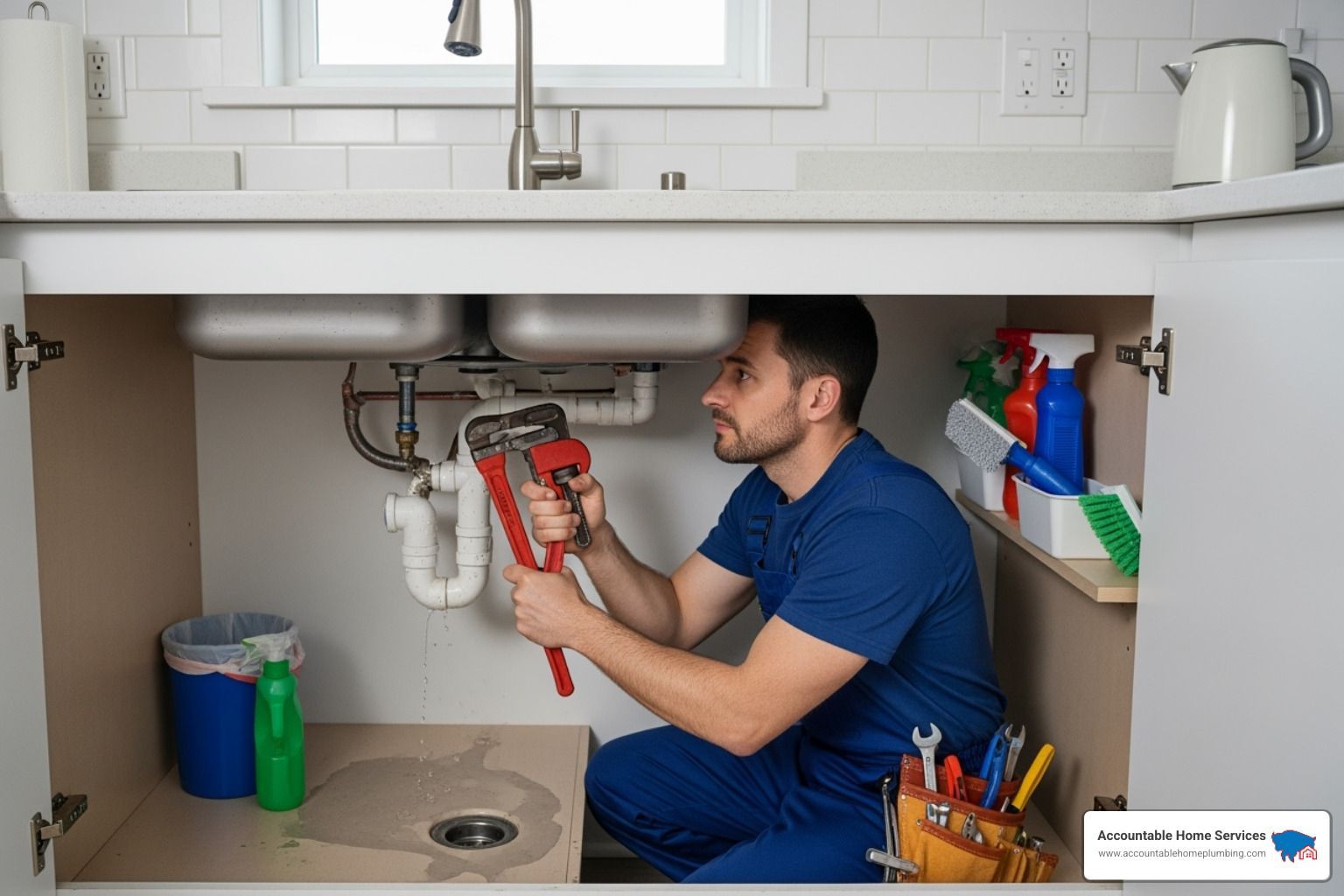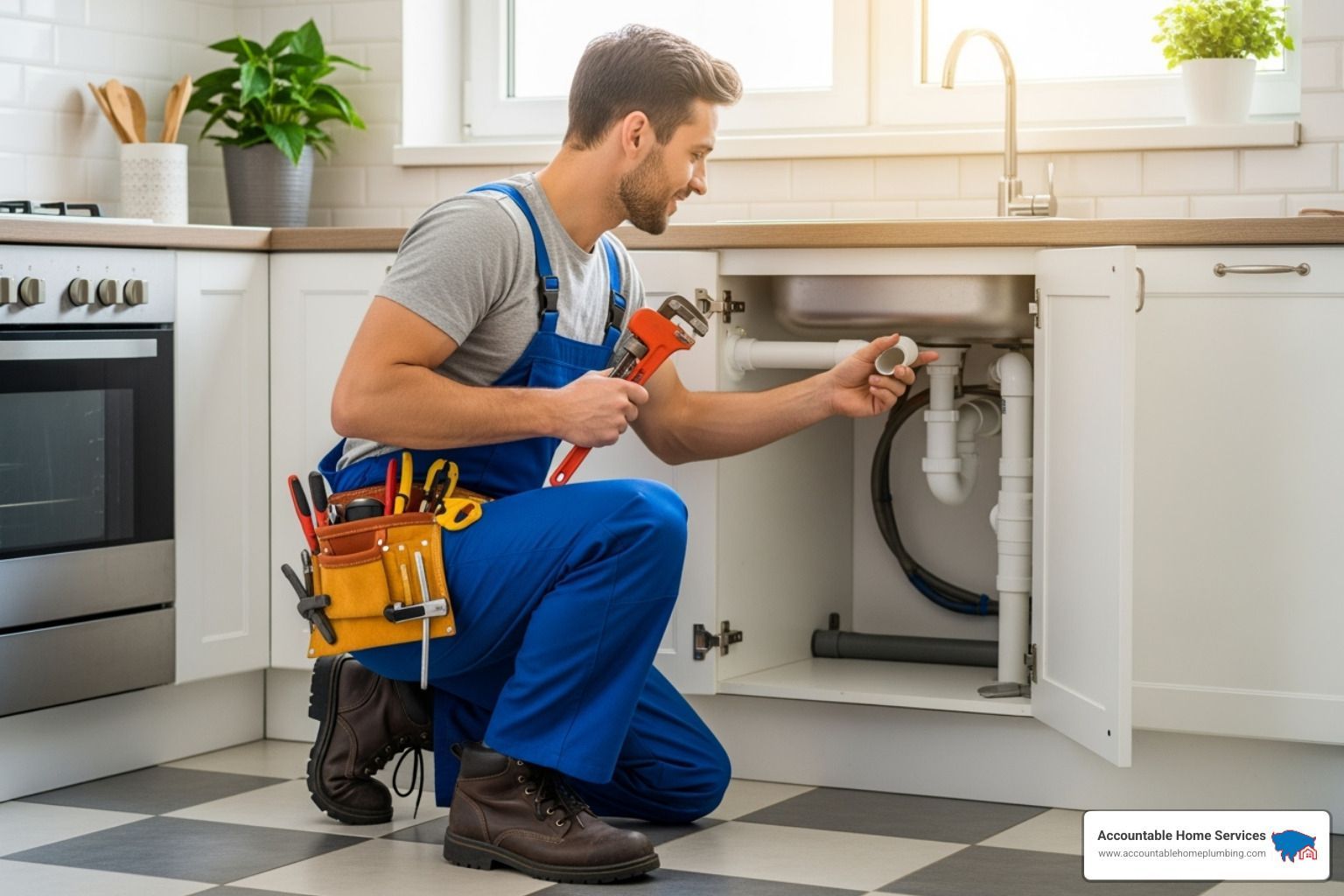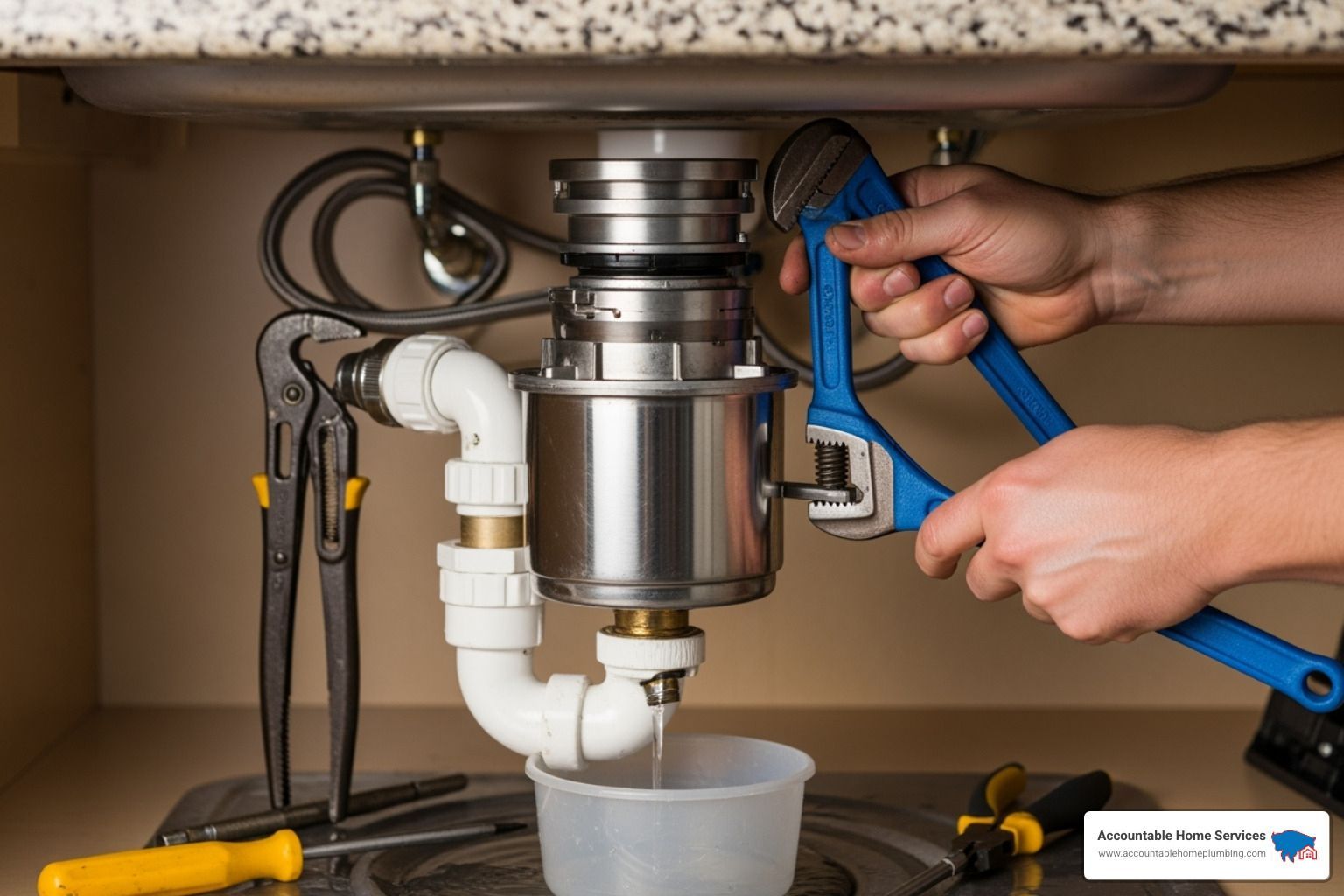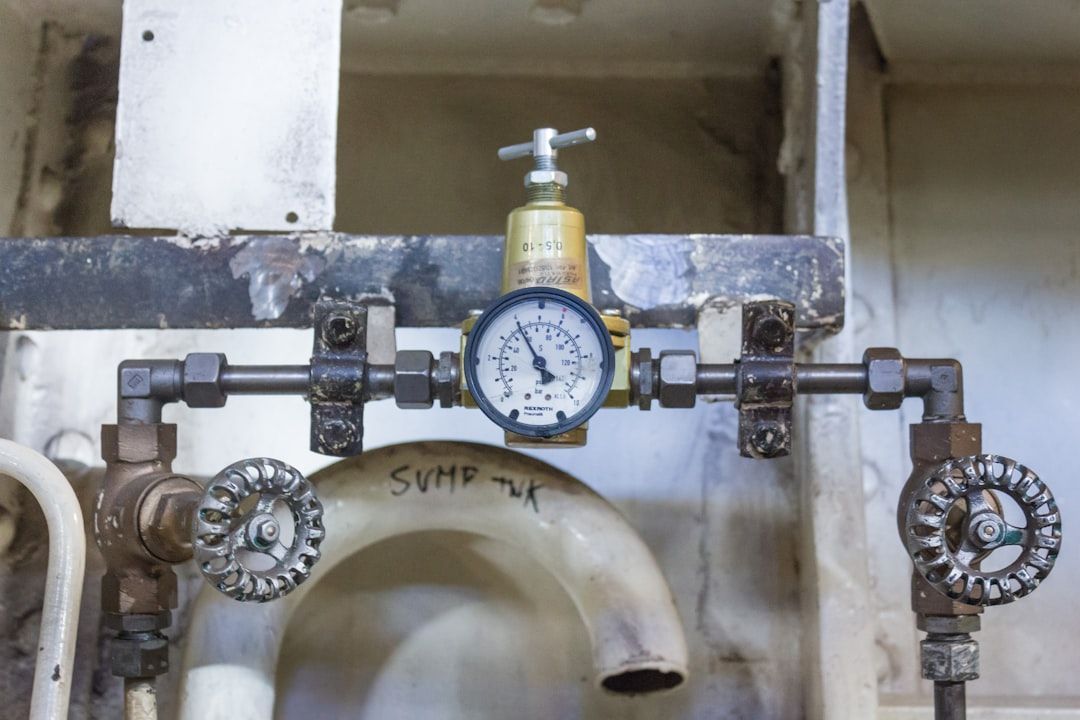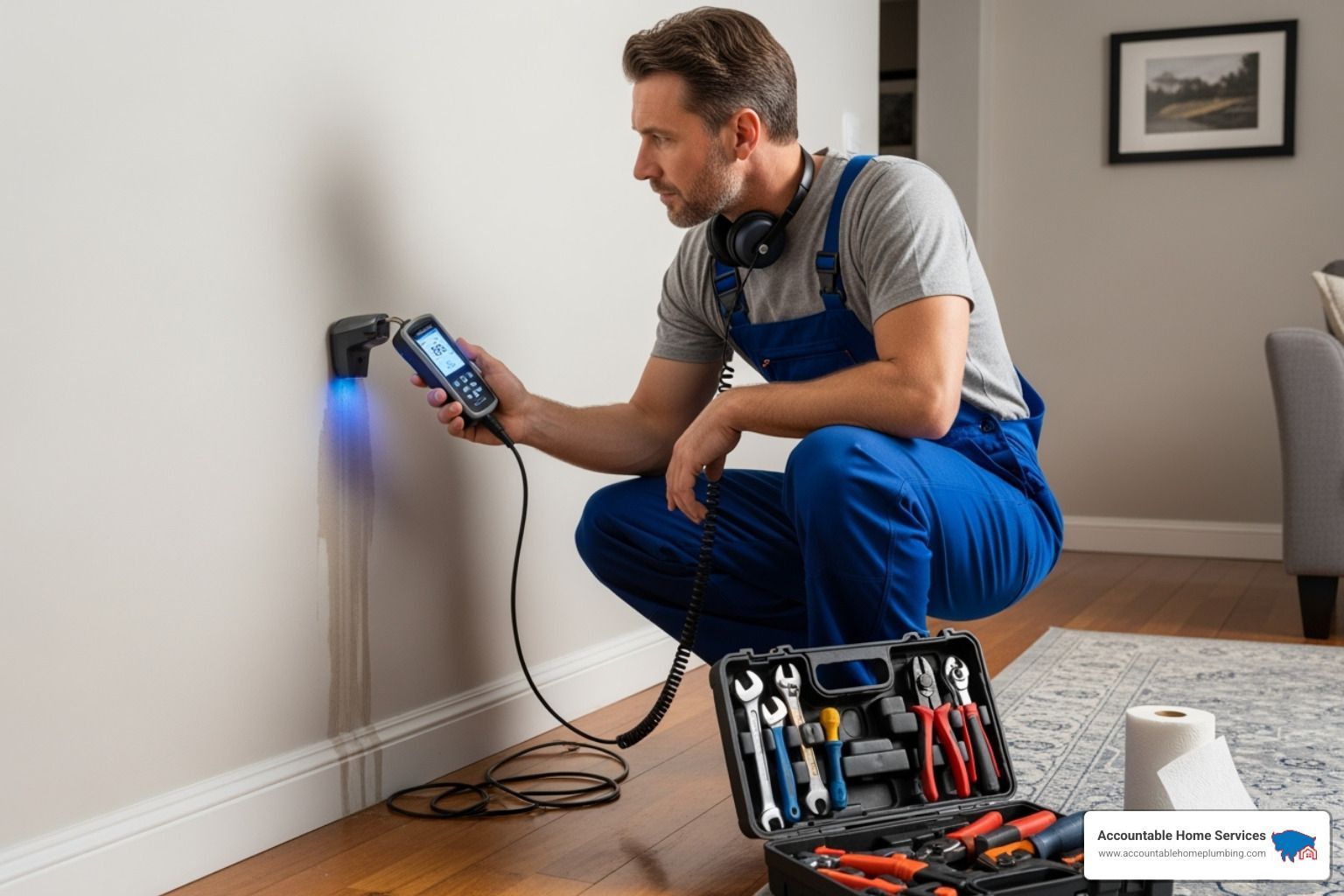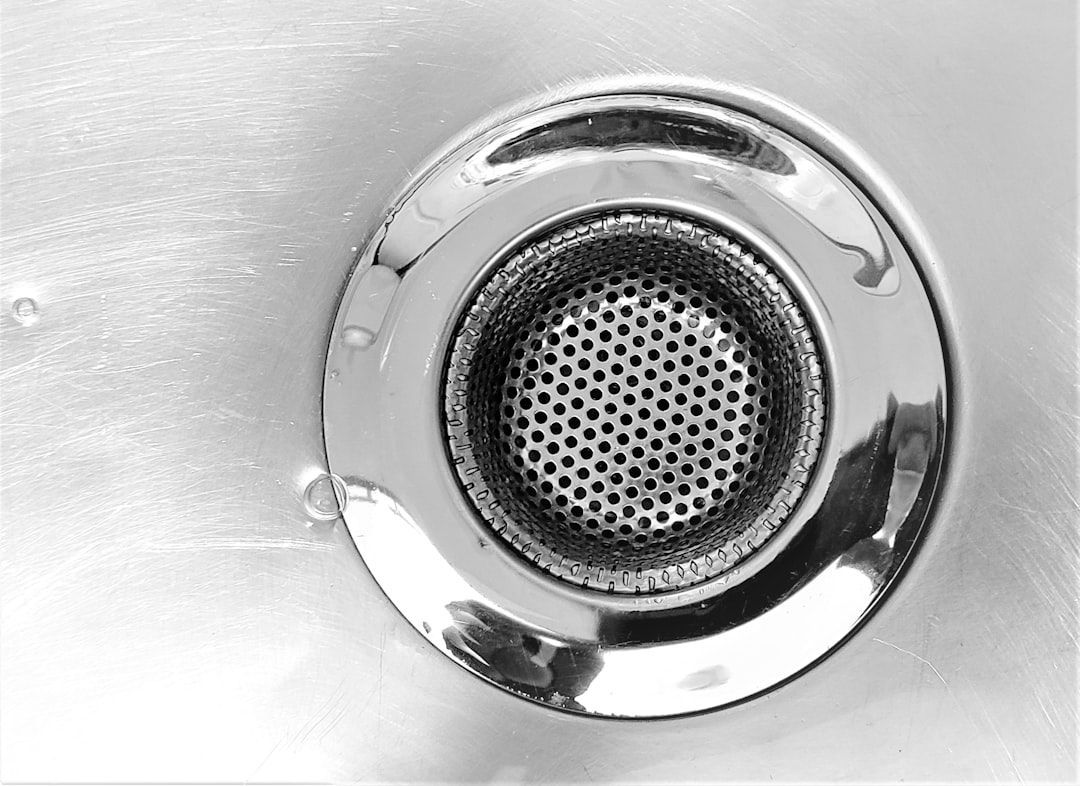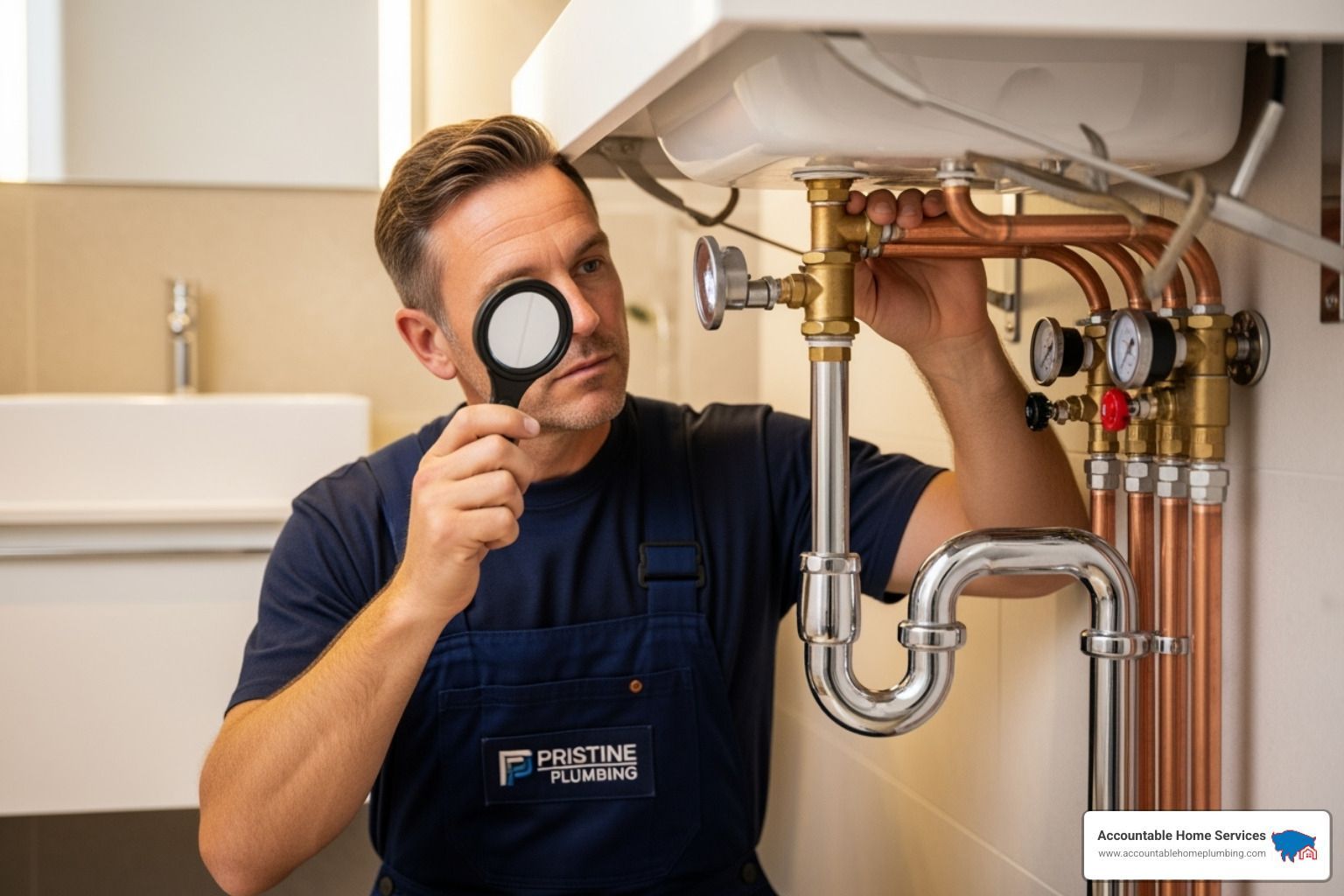Toilet Troubles? Quick and Easy Toilet Choke Solutions
Toilet Clogs: Fast-Acting Solutions
If you're facing a toilet choke solution emergency right now, here's what to do:
- Stop the water flow - Close the flapper in the tank or shut off the water valve behind the toilet
- Try plunging - Use a flange plunger with a good seal and vigorous up-and-down motion
- Use dish soap and hot water - Pour ¼ cup dish soap followed by hot (not boiling) water
- Try baking soda and vinegar - Add 1 cup baking soda followed by 2 cups vinegar, wait 30 minutes
- Use a toilet auger - Insert a rubber-coated closet auger and crank clockwise
A toilet choke solution is something every homeowner needs at some point. That moment of panic when you flush and the water rises instead of drains is universal. Whether it's excessive toilet paper, a child's toy, or mysterious bathroom debris, a clogged toilet disrupts your home's comfort and hygiene.
Toilet clogs occur when something blocks the trapway—that curved section of your toilet that creates the water seal. While many clogs clear with simple DIY methods, others require professional attention, especially in older homes or HDB buildings with narrow pipes.
I'm Mike Martinez, owner of Accountable Home Plumbing in Denver. With over 15 years of experience providing toilet choke solutions, I've seen and fixed every type of clog imaginable, from simple paper blockages to serious sewer line issues requiring specialized equipment.
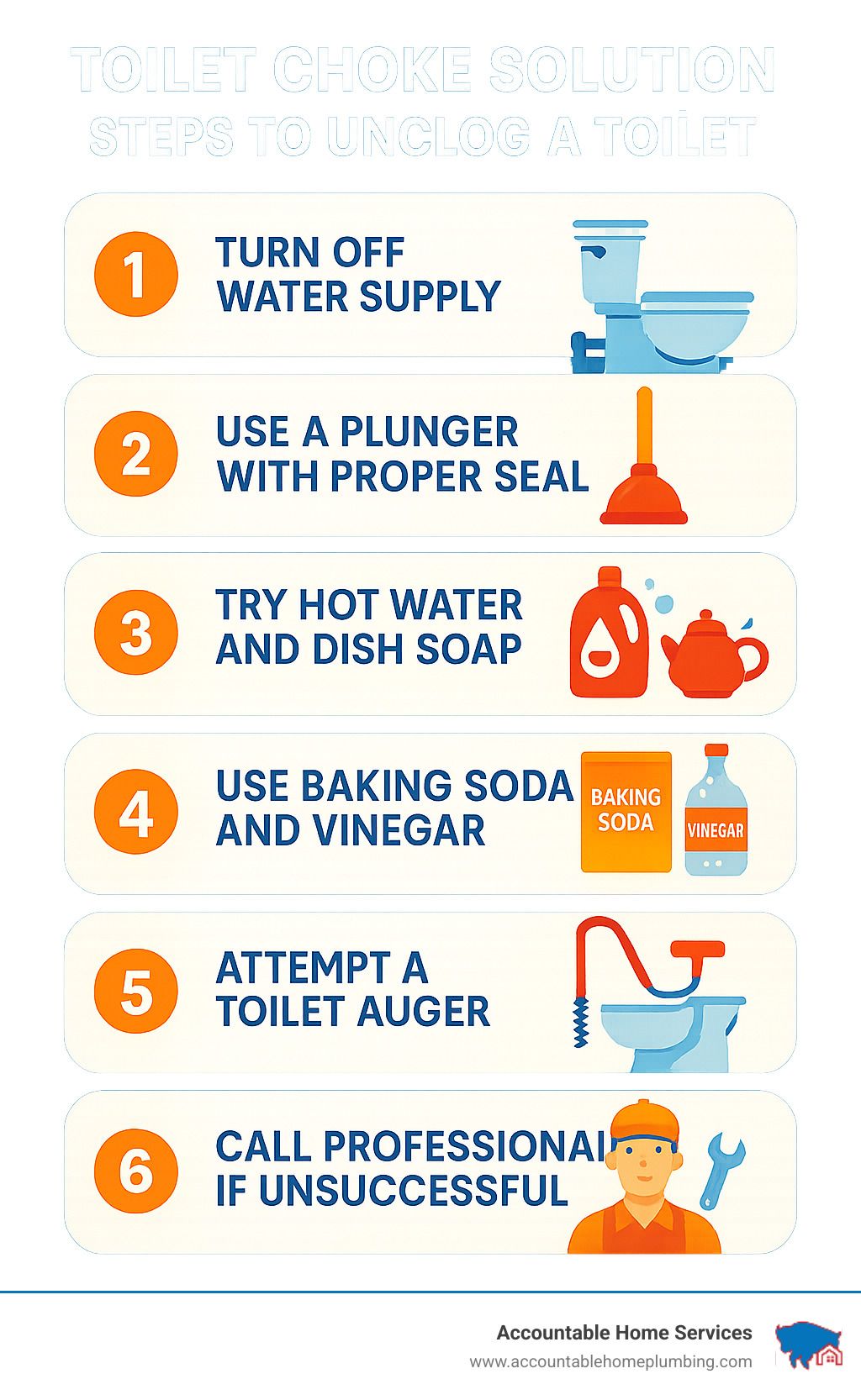
What Causes a Toilet Choke?
Ever wondered why your toilet decides to rebel against you at the most inconvenient times? As we've finded while helping thousands of Denver homeowners, toilet clogs happen for several common reasons.
Foreign objects are frequent culprits. One of our plumbers once had to fish out a plastic baby Jesus figurine from a Westminster home's toilet! While kids are often responsible for these trip-seeking items, adults accidentally drop things too – from phones to jewelry.
Excessive toilet paper remains the most common cause we encounter. Modern low-flow toilets simply weren't designed to handle those "just to be safe" extra handfuls of paper some of us use.
Those supposedly "flushable" wipes are a major problem – they're responsible for about 30% of severe clogs we fix in Broomfield and Thornton. Despite what the packaging claims, these wipes don't break down like toilet paper.
Many newer homes have low-flow toilet designs that save water (great for the environment!) but come with less flushing power to move waste through pipes (not so great for preventing clogs).
Vent stack issues might sound technical, but they're simply about airflow. Your plumbing needs air to flow properly – when vent stacks get blocked, they create vacuum issues that prevent proper flushing.
Deeper in your plumbing system, sewer line blockages from tree roots, collapsed pipes, or buildup can create backups that affect your toilet's performance.
In older Denver neighborhoods, aging pipes gradually narrow over time due to mineral buildup, making clogs increasingly common as your home ages.
As our senior technician often says, "Most toilet choke solutions start with understanding what shouldn't go down your toilet in the first place. We've found everything from hairbrushes to kids' jewelry causing major blockages."
Anatomy of a Toilet & Trap
To truly understand toilet clogs, you need to know the inner workings of your porcelain throne:
Your toilet's trapway is the S-shaped channel at the bottom of the bowl. This clever design creates the siphon action that removes waste while maintaining a water seal preventing sewer gases from entering your home.
The siphon action is what makes the magic happen. When you push that lever, water rushes from the tank, creating pressure that pushes waste through the trapway and starts a siphoning effect that clears the bowl.
Inside the tank, the flapper (that rubber valve) controls water release during flushing. If it doesn't seal properly after flushing, water continues running, potentially causing overflow disasters during a clog.
That standing water in your toilet bowl isn't just there for looks – the water seal serves as a crucial barrier against sewer gases and helps initiate the flush process.
While brilliantly designed, the trap is vulnerable to blockages, especially at the narrowest point of the trapway – exactly where most clogs occur. Understanding this design helps explain why a toilet choke solution often requires tools that can steer this curved pathway.
Scientific research on venting shows proper air circulation is just as important as water flow in maintaining a properly functioning toilet system.
Spot the Signs Before the Overflow
Ever been in the middle of a relaxing shower when you hear that ominous gurgle from the toilet? That's your plumbing trying to tell you something important! Catching these early warning signs can save you from a messy bathroom disaster.
Slow flushing is often the first red flag that trouble is brewing. When your normally powerful flush starts looking more like a lazy river, something's restricting water flow down there. This isn't normal, and it won't fix itself.
Those gurgling sounds coming from your toilet bowl aren't just random noises—they're air bubbles trying to escape through water as they steer around a partial blockage. Think of it as your pipes gasping for breath.
Have you noticed the water level rising higher than usual during a flush, maybe even coming uncomfortably close to the rim? Your toilet is struggling against resistance, and it's only a matter of time before it loses the battle completely.
Unusual odors wafting from your bathroom can indicate that sewer gases are finding their way past water seals due to developing clogs. Your nose knows—don't ignore these unpleasant warnings!
The toilet "burp" is particularly telling—that distinctive sound of air escaping when you flush signals negative pressure in your drain pipes. It's like your plumbing is belching after a bad meal, and that meal might soon be all over your floor.
If you find yourself reaching for the plunger on a weekly basis, you're not dealing with bad luck—there's likely a deeper issue lurking in your pipes that needs professional attention.
One Boulder homeowner learned this lesson the hard way: "I ignored the gurgling for weeks. By the time I called Accountable Home Plumbing, sewage was backing up into my shower. I wish I'd recognized the warning signs earlier."
Hidden Red Flags in Older & HDB Buildings
If you live in an established Denver neighborhood or multi-unit building, your plumbing system faces some unique challenges that make it especially vulnerable to toilet chokes.
Those charming older homes often come with narrow drain lines—typically 2 inches compared to the modern 3-inch standard. That extra inch makes a huge difference in what can safely pass through your pipes.
In apartment buildings and condos, your bathroom's fate isn't entirely in your hands. Shared waste stacks mean your neighbor's flushing habits directly impact your plumbing. That family with three toddlers upstairs? Their "flushable" dinosaur toys could become your problem.
Corroded pipes are another hidden enemy in older buildings. Decades of water flow creates rough interior surfaces where debris catches and builds up, gradually narrowing your pipes from the inside out.
Mysterious drainage problems might actually be slab leaks—issues with pipes buried beneath your home's concrete foundation. These are particularly tricky because the real problem isn't where you see the symptoms.
Many homes built before current regulations have plumbing that doesn't meet modern compliance codes, with inadequate venting or improper pipe slopes that make clogs almost inevitable.
A Longmont property manager shared this cautionary tale: "In our 1950s apartment building, we had recurring toilet clogs until Accountable Home Plumbing identified a partially collapsed sewer line. The tenants had been dealing with slow drains for months, thinking it was normal for an old building."
Don't accept poor plumbing performance as the cost of vintage charm. These warning signs deserve attention before they escalate into a full-blown toilet choke emergency requiring a more extensive (and expensive) solution.
Immediate Toilet Choke Solution Steps
When toilet trouble strikes, quick action is your best friend. As someone who's helped countless Denver homeowners through plumbing emergencies, I can tell you that those first few minutes matter most in preventing a minor clog from becoming a major disaster.
First things first: locate the shut-off valve behind your toilet near the floor. Give it a clockwise turn until it stops. This simple step cuts off the water supply and gives you breathing room to address the clog without fear of more water joining the party.
If water continues flowing from the tank, it's time for a hands-on approach. Remove the tank lid and press down on the rubber flapper inside—this is the valve that controls water flow from tank to bowl. Holding it closed manually can stop water in its tracks when you need it most.
Is your bowl already threatening to spill over? Don't panic! Put on rubber gloves (always a must for toilet work) and carefully remove some water using a cup or small container, transferring it to a bucket. This buys you precious inches between the water and your bathroom floor.
Speaking of floors, protect yours with towels around the toilet's base. They'll catch splashes and contain small spills, saving your bathroom mats and potentially your subfloor from water damage.
"I've watched too many homeowners make the same mistake," says our senior technician. "They keep hitting the flush handle hoping for a different result. Instead, they end up with water everywhere except where it belongs."
Primary Toilet Choke Solution Checklist
Before diving into any toilet choke solution, make sure you've covered these bases:
Turn off that water supply completely—no exceptions. The last thing you need is more water entering an already troubled system. And please, resist the urge to flush again. I know it's tempting, but additional flushes almost always lead to overflow.
Take a moment to assess what you're dealing with. Is there something visible causing the clog? Sometimes a child's toy or other object might be retrievable without special tools. Then gather your unclogging arsenal before starting—having your plunger, auger, or other supplies within reach prevents dripping across your bathroom mid-project.
Always wear rubber gloves when handling toilet issues. This isn't just about the "yuck factor"—it's about protecting yourself from household chemicals and bacteria. If you're planning to use chemical solutions, consider eye protection too.
Emergency Measures to Prevent Overflow
When that water level keeps rising and your heart rate along with it, here's what to do:
The bucket bail-out technique is your first line of defense. Carefully scoop water from the bowl into a bucket until the level drops to a safer height. If you happen to have a wet/dry vacuum handy, it can extract excess water quickly—but never, ever use a regular household vacuum for this job.
Do you have a floor drain in your bathroom? Make sure the area around it is clear so any accidental overflow has somewhere to go. Creating a towel dam around the toilet can also help direct water toward a drain instead of under your vanity or into the hallway.
"I remember a frantic call from a customer in Arvada," our emergency technician shared. "Water was already spilling onto her bathroom floor when she called. The first thing we told her was to close the water supply valve while we rushed over. That simple step saved her thousands in potential water damage."
When toilet emergencies happen, the team at Accountable Home Plumbing is just a phone call away, ready to provide a professional toilet choke solution when DIY methods aren't enough. But these immediate steps can make all the difference while you wait for help to arrive.
DIY Toilet Choke Solution Methods That Work
When faced with a clogged toilet, these proven methods can save you a service call and get your bathroom back in working order:
Toilet Choke Solution With a Plunger
A proper plunger is your first line of defense against toilet clogs, and when used correctly, it resolves about 90% of common blockages.
The secret to plunger success is choosing the right type—you need a flange plunger (sometimes called a "toilet plunger") with that extra rubber flap that fits into the drain opening. Those flat sink plungers just won't create the necessary seal.
"The biggest mistake I see is people using the wrong plunging technique," says our Westminster plumbing supervisor. "It's not about random pushing—it's about creating pressure and suction in a controlled rhythm."
To use a plunger effectively, make sure there's enough water in the bowl to cover the flange, then create a proper seal over the drain opening. Start with a gentle push to expel air, then plunge vigorously with straight up-and-down motions. Maintain the seal throughout and pull up sharply on the final stroke to break the vacuum.
Pro tip: Run hot water over your plunger before using it to soften the rubber, creating a better seal against the porcelain.
Toilet Choke Solution Without a Plunger
Don't worry if you find yourself without a plunger when disaster strikes. Several household items can come to your rescue:
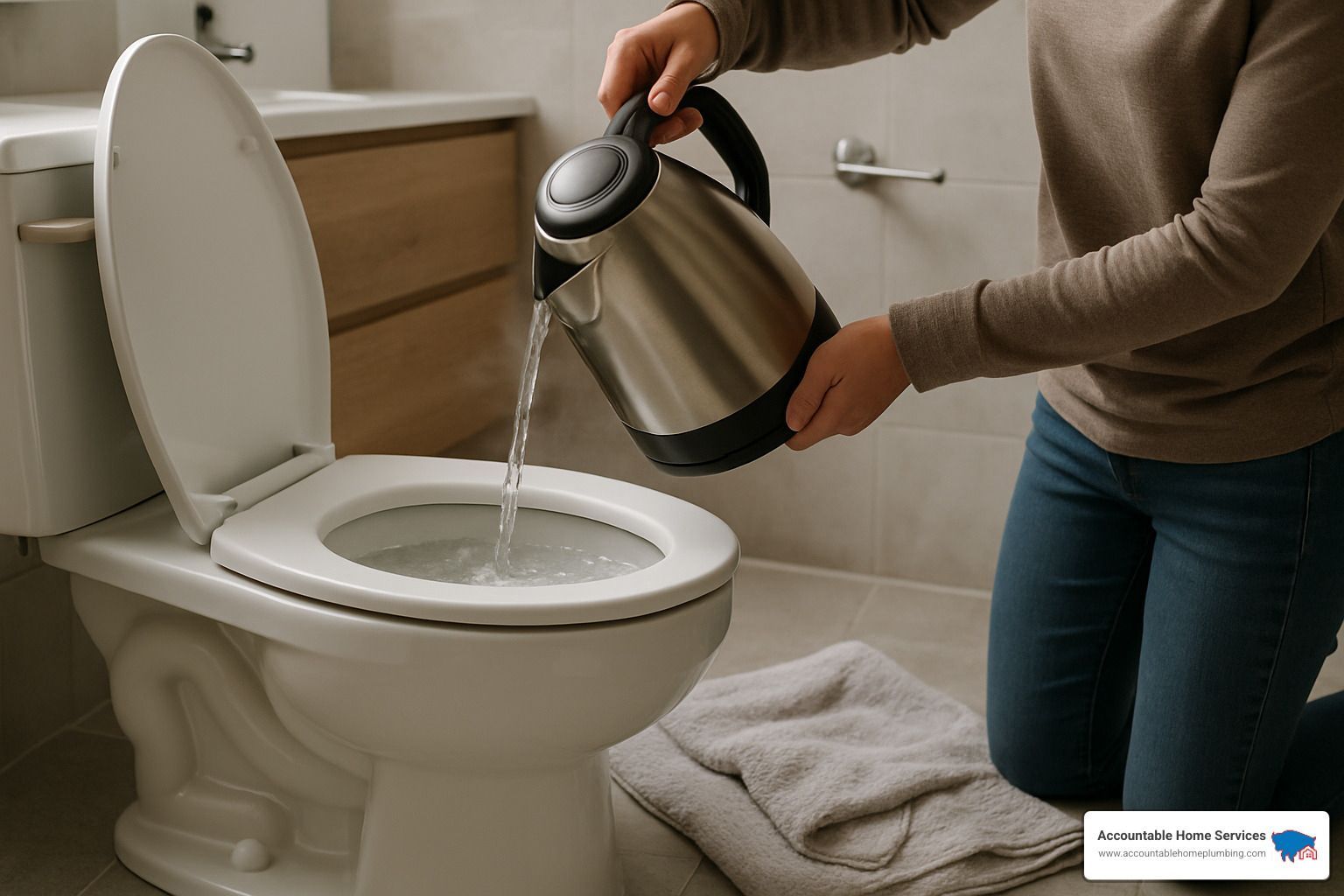
The dish soap and hot water method works surprisingly well. Pour about ¼ cup of dish soap into the toilet bowl, then carefully add a gallon of hot (not boiling) water from waist height. The soap lubricates the clog while the hot water helps break down organic materials. Let this mixture sit for 5-10 minutes before flushing.
A Denver customer told us: "I was skeptical, but the dish soap trick worked like magic on my clogged toilet. The soap lubricated everything and the clog slipped right through."
For stubborn clogs, try a DIY Drain Bomb. Mix 2 cups baking soda, 8-10 tablespoons dish detergent, and ¼ cup Epsom salt into a moldable mixture. Drop it into the toilet with 4 cups of water and wait 30-60 minutes before flushing. The fizzing action helps break up the blockage.
In a pinch, a wire hanger snake can work wonders. Straighten a wire coat hanger while keeping the hook at one end, then wrap a small cloth around the hook to prevent scratching your porcelain. Gently maneuver it into the drain to break up or retrieve the clog.
Using a Toilet Auger or Plumbing Snake
For those stubborn clogs that laugh in the face of plungers, a toilet auger (also called a closet auger) is your next best option.
To use an auger effectively, place the curved end into the toilet bowl with the sleeve against the drain opening. Turn the handle to extend the cable into the drain while maintaining steady pressure. Always rotate clockwise as this helps the auger break through or grab the obstruction. You'll either pull out the blockage or break it up enough to flush down.
"We recommend homeowners invest in a rubber-coated auger to prevent porcelain scratches," advises our Northglenn plumbing team. "It's worth the extra few dollars to protect your toilet."
Don't forget to thoroughly clean your auger with disinfectant after each use—it's been places you don't want to think about!
Safer Alternatives to Chemical Drain Cleaners
While it might be tempting to reach for a bottle of chemical drain cleaner, think twice. These harsh chemicals can damage pipes (especially older ones), harm the environment, pose health risks if splashed, and rarely work on complete blockages. Ironically, they can even make future clogs worse by creating rough spots in your pipes where debris catches.
Instead, consider enzyme/bio cleaners like BioBen that use natural bacteria and enzymes to digest organic material without harming pipes. These gentler alternatives are safe for all plumbing and septic systems, environmentally friendly, and continue working for weeks after application, helping prevent future clogs.
"After multiple chemical drain cleaner disasters, I switched to enzyme cleaners for monthly maintenance," reports a Boulder homeowner. "I haven't had a serious clog in over two years."
When to Stop & Call a Pro
While DIY methods work for most clogs, sometimes you need professional help. It's time to call us at Accountable Home Plumbing when:
You're dealing with a persistent clog that multiple attempts with different methods haven't fixed. If multiple fixtures are backing up, that's a clear sign of a sewer line issue beyond DIY solutions. A persistent sewer smell suggests a venting or sewer problem that needs professional diagnosis.
Water on the floor leaking from the base of your toilet needs immediate attention, as do recurring clogs that happen frequently despite your best efforts. And if you hear unusual gurgling sounds in multiple drains, that indicates a main line problem requiring specialized equipment.
"A customer in Arvada tried everything to unclog his toilet," our service manager recalls. "When we arrived, we finded tree roots had infiltrated his sewer line. No amount of plunging would have fixed that—it required professional equipment."
There's no shame in calling for backup when a toilet choke solution is beyond your DIY capabilities. That's exactly what we're here for at Accountable Home Plumbing.
When DIY Fails: Calling in the Pros
Let's face it – sometimes that stubborn toilet clog just won't budge, no matter how much elbow grease you apply. When you've tried everything in your DIY arsenal, it's time to wave the white flag and call in the cavalry. Don't worry, it happens to the best of us!
At Accountable Home Plumbing, we bring specialized tools and expertise that simply aren't available at your local hardware store:
Our professional plumbers use waterproof camera inspections to see exactly what's causing your toilet troubles. This technology lets us peek inside your pipes to pinpoint the exact location and nature of the blockage – no guesswork involved.
For those stubborn clogs that refuse to budge, we bring out the big guns: hydro-jetting. This powerful method uses high-pressure water jets that can blast away even the most stubborn blockages while being gentle on your pipes. It's like power-washing the inside of your plumbing!
"After spending a full weekend trying to clear my toilet, I finally called Accountable," shares a Thornton resident. "Their technician found and removed a small toy in minutes. I wish I'd called sooner."
In more severe cases where damage has occurred, we may recommend pipe replacement. While this sounds dramatic, sometimes replacing a damaged section is the most cost-effective long-term solution.
Speaking of costs – consider the math. Professional toilet choke solution services typically cost far less than repairing water damage from an overflow or fixing DIY attempts gone wrong. We've seen too many Denver homeowners create bigger problems trying to save a few bucks.
One thing you'll never experience with us is price shock. Transparent pricing is our promise – we provide upfront costs before beginning any work, so there are no unpleasant surprises when the job is done.
What to Expect From a Professional Visit
When you call Accountable Home Plumbing for your toilet choke solution, here's our process:
Your experience begins with our arrival checklist. Our uniformed technicians arrive promptly within the scheduled window, fully equipped with all necessary tools and parts. No running back to the shop for that "one thing" we forgot!
Before touching a single tool, we provide a clear, upfront quote after assessing your specific situation. You'll know exactly what you're paying before we start – that's our accountability promise.
We treat your home with respect, using protective measures like floor mats and booties to keep your space clean. Your bathroom shouldn't look like a disaster zone just because your toilet had issues.
We believe in thorough resolution – not just quick fixes. Our techs don't simply clear the visible clog; they ensure the entire line is flowing properly to prevent a repeat performance next week.
All our work comes with a satisfaction guarantee. We stand behind our repairs with a solid warranty because we're confident in our workmanship.
"What impressed me most was how clean they left my bathroom," notes a Denver customer. "Despite dealing with a messy clog, there was no evidence they'd been there except for my perfectly functioning toilet."
When DIY methods fail, calling professionals isn't admitting defeat – it's making a smart decision to protect your home and get the job done right the first time. Your toilet troubles don't have to become plumbing nightmares when you have the right team on speed dial.
Preventing Future Toilet Chokes
Let's face it—the best toilet choke solution is avoiding the problem altogether. As someone who's unclogged countless Denver toilets, I can tell you that prevention saves both money and the particular brand of stress that comes with watching toilet water rise toward the rim.
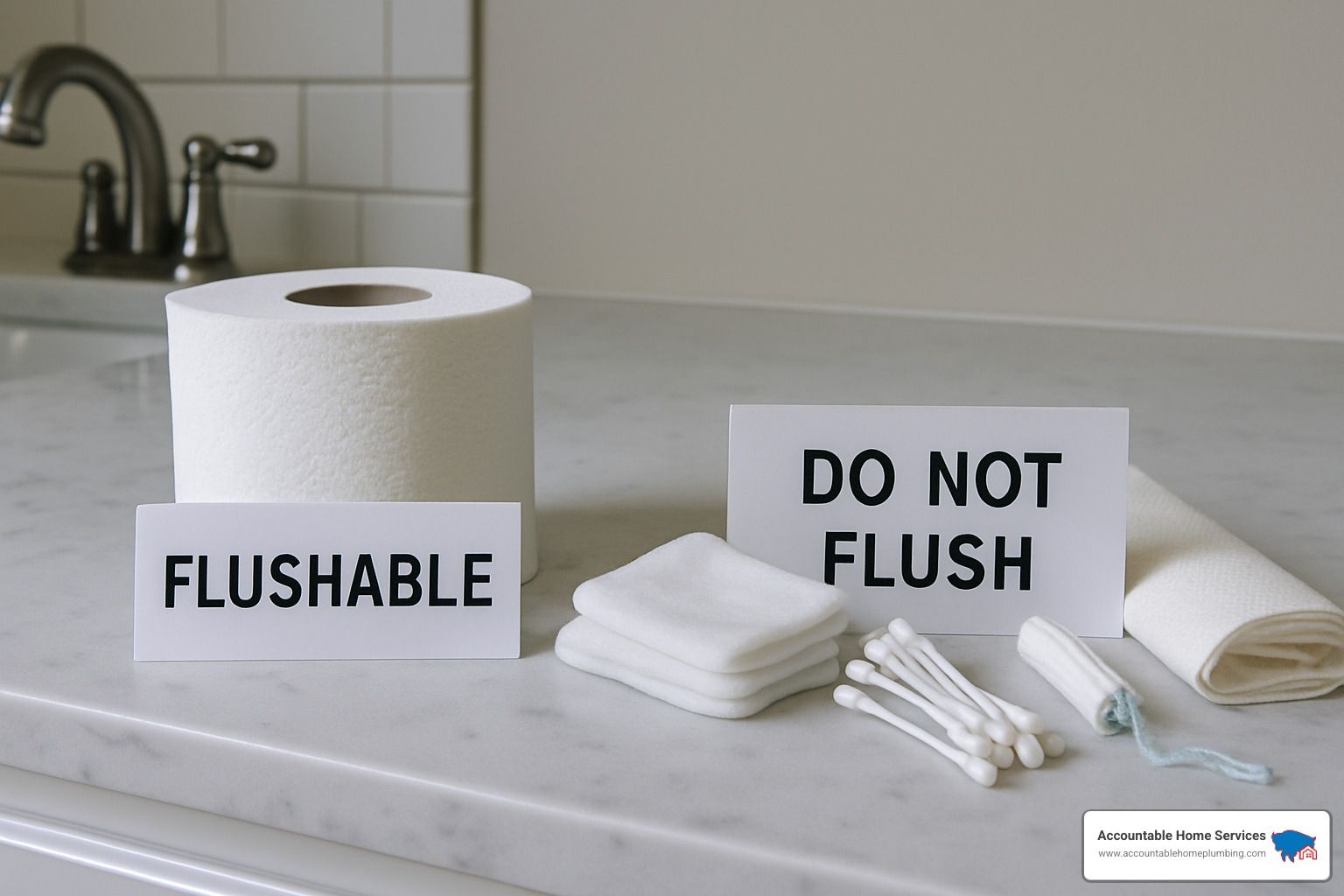
Developing flush-friendly habits makes all the difference. When dealing with larger amounts of waste or toilet paper, consider flushing twice instead of trying to send everything down at once. Your pipes will thank you. I always remind my customers about the simple 3Ps rule—only flush pee, poop, and (toilet) paper. Everything else belongs elsewhere.
Monthly maintenance isn't just for your car—your plumbing needs regular care too. A simple enzyme treatment costs around $10 and can prevent a $250 emergency call. These biological cleaners work continuously, breaking down potential clogs before they form.
If you have little ones at home, take time to teach them that toilets aren't toys or mysterious disappearing portals. One Denver mom told me how she turned it into a game: "We have toilet-approved items and toilet-forbidden treasures. My four-year-old now proudly announces when something belongs in the trash instead."
A small bathroom bin is your toilet's best friend. Place one in every bathroom for items that might otherwise be tossed into the bowl. This simple step prevents countless clogs.
"Prevention is much cheaper than emergency service," our maintenance specialist often says. "The worst time to shop for a plunger is when you're already ankle-deep in trouble."
Items You Should NEVER Flush
Over the years, our plumbers have fished some truly surprising items from Denver toilets. Despite what packaging claims, "flushable" wipes don't break down like toilet paper and cause nearly a third of serious clogs we encounter.
Feminine products are particularly problematic—they expand in water and easily catch on pipe joints. The same goes for cotton balls and swabs, which maintain their structure long enough to create blockages.
Parents, be watchful of toys and small objects that curious little hands might send on a porcelain trip. And everyone should avoid flushing grease or oil, which solidifies in pipes and creates a sticky trap for other debris.
Medication might seem harmless, but it passes through treatment plants and harms our environment. Similarly, paper towels and tissues are designed to stay strong when wet—exactly what you don't want in plumbing.
Even everyday items like hair, dental floss, and cat litter can cause surprising damage. Floss creates net-like structures that catch other debris, while even "flushable" cat litter expands dramatically in water.
One Westminster customer was genuinely shocked when we pulled a tangled mass of dental floss and hair from their line. "I had no idea these everyday items could cause such problems," they admitted. It's a common misconception.
Ongoing Maintenance & Bio Treatments
Think of toilet maintenance like dental care—regular attention prevents painful emergencies. Here's what works best for my Denver customers:
Pour an enzyme-based drain cleaner into your toilet monthly. These friendly bacteria digest organic buildup before it becomes problematic. Unlike harsh chemicals, they continue working for weeks after application.
Don't forget those rim-jets under the toilet bowl's edge. Use your toilet brush weekly to clear mineral deposits that can weaken flush power. It takes just seconds but makes a noticeable difference.
Have your plumbing vent stack checked annually. These often-forgotten pipes allow air into your system, and when blocked by leaves, bird nests, or even snow, they can cause slow drains throughout your home.
Pay attention to your water pressure. Low pressure means weak flushes, which can leave material behind to form clogs. And never ignore small leaks—they're often warning signs of bigger issues developing.
At Accountable Home Plumbing, we offer annual maintenance plans that include these preventive treatments and inspections. Our data shows customers on these plans have 80% fewer emergency calls than those who wait for problems to develop.
As one Boulder customer told me after switching to regular maintenance: "I used to think plumbers were for emergencies. Now I understand they're better at preventing them."
Frequently Asked Questions about Toilet Choke Solutions
Why does my toilet choke repeatedly even after plunging?
If you find yourself in a frustrating cycle of plunging the same toilet over and over, you're not alone. Many Denver homeowners face this issue, and it usually points to something deeper than just a simple clog.
Partial obstructions often hide in your plumbing system. That toy or wad of paper might temporarily move when you plunge, only to settle back into a problematic position once you start using the toilet again.
Your home's vent stack could also be the culprit. These important pipes allow air into your plumbing system, and when they're blocked (often by leaves or even a bird's nest), they create vacuum issues that prevent proper flushing.
Some older low-flow toilets were, frankly, not designed very well. The early models tried to conserve water but often lacked the flushing power needed to move waste effectively. If your toilet was manufactured between 1994-2000, this might be your issue.
Sewer line problems are perhaps the most serious cause. As one of our technicians explains: "A Broomfield customer called us six times in two months for toilet clogs. We finally did a camera inspection and found tree roots infiltrating their sewer line. After hydro-jetting and root treatment, their problems disappeared."
Can hot water crack my porcelain toilet bowl?
This is definitely a valid concern, and I'm glad you asked. The short answer is yes, it can—if you're not careful.
Temperature matters significantly when using hot water as a toilet choke solution. The water should be hot enough to help break down clogs (around 120-130°F) but never boiling. Think hot shower water, not tea kettle water.
Porcelain, while durable, doesn't handle rapid temperature changes well. When extremely hot water hits the cooler porcelain, the material expands unevenly, which can lead to cracks.
If you do use the hot water method, pour slowly and aim for the center of the bowl where the water already sits, not directly onto dry porcelain surfaces. This allows the temperature to change more gradually.
"I've seen toilets cracked from pouring boiling water directly into them," warns our repair specialist. "The repair cost far exceeds any savings from avoiding a professional service call."
If you're worried, use warm water instead and just allow it more time to work on the clog. Patience often pays off better than extreme heat!
How much does a professional toilet choke solution cost?
Let's talk about the bottom line. At Accountable Home Plumbing, we believe in transparency, so here's what you can expect to pay for professional help with your clogged toilet:
A standard toilet clog typically costs between $149-$249, with the exact price depending on how complex the job is and how long it takes. Most simple clogs fall at the lower end of this range.
If we need to perform a camera inspection to find a deeply hidden blockage, that's an additional $99-$199. This specialized equipment lets us see exactly what and where the problem is, eliminating guesswork.
For severe blockages that require hydro-jetting (essentially power-washing your pipes from the inside), expect to pay $299-$599. While more expensive, this method is incredibly effective at clearing even the most stubborn blockages.
Need help after hours? Our emergency service carries an additional charge of $75-$150, depending on the time and day. Late night holiday calls naturally fall on the higher end.
"We pride ourselves on transparent pricing," emphasizes our customer service manager. "We give you the exact cost before starting work, and that price doesn't change even if the job takes longer than expected."
Conclusion
Let's face it—dealing with a clogged toilet isn't anyone's idea of a good time. But armed with the right knowledge and tools, a toilet choke solution doesn't have to ruin your day or your bathroom floor.
From the simple yet effective plunger technique to the surprisingly powerful dish soap and hot water method, you now have several proven strategies to tackle most clogs that come your way. You've learned when to roll up your sleeves for DIY solutions and, just as importantly, when it's time to call in the professionals.
The best approach to toilet troubles is preventing them in the first place. Being mindful about what goes down your toilet (stick to the 3Ps!), performing regular maintenance with enzyme treatments, and addressing small issues before they become major blockages will save you time, money, and stress in the long run.
At Accountable Home Plumbing, we've seen it all—from toy dinosaurs to mysterious "flushable" wipe mountains and everything in between. We're your Denver Metro area allies when toilet troubles strike, available 24/7 when DIY methods just aren't cutting it. Our team arrives promptly with clear, upfront pricing and all the specialized equipment needed to resolve even the most stubborn clogs.
"Most of our customers tell us they wish they'd called sooner," shares our customer service manager. "There's a special look of relief when we solve a problem they've been battling for hours or even days."
Don't let toilet troubles disrupt your home or your peace of mind. Whether you're in Broomfield watching water rise with dread, in Westminster with a mysterious recurring clog, or anywhere else in the Denver Metro area, we're just a phone call away.
For preventative maintenance that keeps your plumbing flowing smoothly or emergency toilet choke solutions when you need them most, contact Accountable Home Plumbing today. Because when it comes to your home's plumbing, accountability isn't just in our name—it's our promise to you.
Learn more about our drain-cleaning services and put toilet troubles behind you for good.

